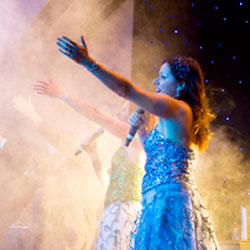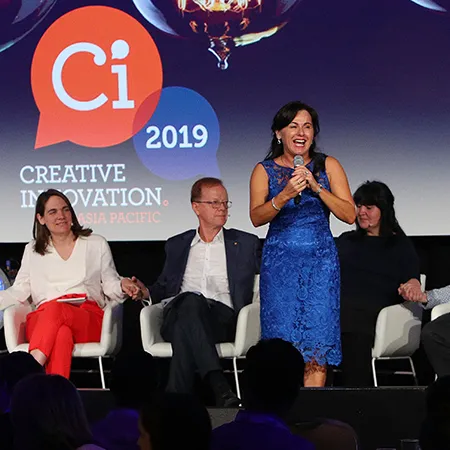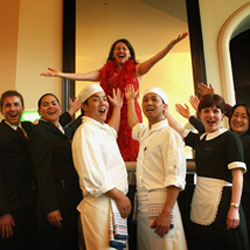While the arts sector faces challenges to secure funding and capture audiences in the digital age, the leading hub for technology and entrepreneurship, Silicon Valley may hold the key to innovation.
It’s challenging to contemplate the future predictions that will change our world. The UN is predicting that up to 47% of middle class jobs will become redundant over the next decade due to robotics and new technologies. We will grow from three to eight billion connected humans online. How will this effect creativity and innovation?
To investigate these changes and challenges, I had just had the great privilege of attending and performing at the Executive Program of Singularity University based in Silicon Valley. Founded by inventor and futurist Ray Kurzweil and XPrize Founder Peter Diamandis, leaders across all sectors from over 24 countries attended the intensive one week program.
SU’s mission is to educate, inspire and empower leaders to apply exponential technologies to address humanity’s grand challenges. We learnt from some of the leading thinkers in the world about topics including artificial intelligence, 3D printing, driverless cars, nanotechnology, the future of work, innovation and biotechnology.
While tech entrepreneurs pour their riches into the next big technology thing, we artists tend to struggle to embrace these technologies and stumble when trying to figure out how to build a fan base and monetise our work in a world without theatres and record stores.
Now film and music compete with Facebook, Twitter, Tumblr, Instagram, Secret, Snapchat, Candy Crush, YouTube, Whatsapp and WeChat for audience attention.
As the leading hub for technology, innovation and entrepreneurship, Silicon Valley may hold the answers for the arts. The area’s high-tech companies attract talent from around the world with more than 60 percent of the college graduates working in technical fields in the Valley born outside of the United States.
This diversity has led to a remarkable cross-pollination of ideas which Harvard Business Review found to be a key factor in nurturing creativity and innovation and the arts can take note.
5 THINGS WE CAN LEARN FROM SILICON VALLEY
1. We need to focus on cross-pollination across art forms and genres
We tend to categorise different art forms, and even different genres within one form, into little boxes. This means that artists working creatively across art forms find it very difficult to gain financial or media support for their work, and therefore, audiences. Some of the most exciting and inventive artists work beyond and between the ‘boxes’ but too often their innovative work never sees the light of day. How often do we hear people in the classical music world scorn crossover music artists? And similarly contemporary musicians don’t believe their art has anything to do with classical music? There are examples of cross art form practitioners doing well in spite of this culture, but it’s not easy.
Now is the time to break down the silos, set aside the boxes and recognise that an artist is a creative human being and their work can span many mediums without diluting the calibre of their art. If their work is of a high quality, inventive, engaging and goes beyond the traditional boxes so much the better. They will be less likely to be taken over by machines.
Technology can provide so many experiences – with advances in virtual reality we will be able to go to the opera at La Scala and experience it truly as it is. Why would anyone go and see a lesser calibre performance when we can be brought the best in the world in the comfort of our own home? Therefore ingenuity and crossover art and performances will become increasingly important if artists are to develop sustainable careers in their chosen profession.
2. We need to foster a results-oriented meritocracy
In the Valley, talent and ability are king. Age, ethnicity, seniority and experience are not what dictate opportunity or responsibility. This cocktail of demographics enables ideas to flow based on merit and encourages connection to other global technology centres for talent and funds.
We need to let go of our traditional models of educating artists and elitist arts organisations and develop artists and companies for a global and collaborative world where technology is king and where creativity and innovation are the keys to future success.
3. We need to build a climate that rewards risk-taking and tolerates failure
No stigma is attached to failure as long as lessons are learned. I like the definition of the word FAIL as First Attempt In Learning. Failure in Australia remains a stigma. Nobody wants to fail and it’s inextricably tied to our culture.
But what really drives Silicon Valley companies is an emphasis on getting things done quickly rather than agonizing over every potential flaw. A sign painted on a wall at Facebook summarizes that attitude: ‘Done is better than perfect.’
As Mark Zuckerberg, CEO of Facebook, has observed: ‘The biggest risk is not taking any risk. In a world that’s changing really quickly, the only strategy that is guaranteed to fail is not taking risks.’
Valley entrepreneurs are also intolerant of government and corporate bureaucracy or anything else that might slow them down.
High value is assigned to experimentation and to incremental, iterative progress rather than trying to figure out everything at the outset of a project. A common mantra is ‘Do it. Try it. Fix it.‘
4. We need to become artist entrepreneurs and stop relying on the government for funding
In the arts we rely heavily on government grants, and yet government is the most risk-averse of all. Until artists can let go of a sense of entitlement and learn how to survive and thrive on their merits we will forever be in the pocket of government. And government will become increasingly ill-equipped to provide any kind of significant funding to the arts due to other more important economic and social challenges. The government will always tend to support the tried and tested rather new innovation.
Creative entrepreneurs in Silicon Valley behave like independent contractors, moving from job to job. The result is a highly mobile talent base in the region, where professionals are significantly more likely than their non-Valley counterparts to receive employment offers from other companies on a regular basis. Many companies see the value in this transfer of people and ideas. Looking to team with people outside one’s own company is also vital.
We need to develop a risk employment culture, encouraging artists to forego some of the financial stability that employment in large arts organisations brings and work in new ways (similar to start-ups) in order to achieve true innovation, longer term success and financial independence. Artists may still work with large organisations but do so as a choice rather than a necessity.
Ideally our large organisations will emulate what the larger Valley organisations do to support emerging talent. They will collaborate and partner with independent artists and small, newer companies providing them with in-kind space, services and revenue streams, helping them shape their products and giving them access to their audiences. They will help to train the next generation of artists and producers creating a realistic succession model as senior people inevitably leave the larger organisations.
5. We need to develop a more open and collaborative environment
Although there is competition in the Valley, there’s an attitude towards sharing. There is a philosophy of cooperation and free interchange of knowledge and experiences. Everybody wants to help everybody and people are willing to divulge how to do start-up, how start-up culture works, the trials and tribulations of being a founder and so on. Nurtured in the heart of the hippie culture of California these people have grown to share and help each other. Similarly, we as artists have that capacity.
In Australia, we certainly see pockets of this, with mentorship becoming an imperative, but Australian culture is held back profoundly by not only an immaturity in how to work together but also defensiveness in competing.
Because working in the arts is such a scarce commodity in Australia, offering your help to someone else can also mean doing favours for a potential competitor and doing yourself out of a job. Somehow we need to be able to see past that and look at how we can work together to build a sustainable future and raison d’être for artists and the arts before it is too late. It’s ultimately all about win-win.
Under a celebrate success culture making money is as important as advancing technology and creating a successful product in the Valley. As artists we need to find meaningful new ways to remain relevant in this era of disruption. Therefore we need to learn and develop the key characteristics of cross-pollination, meritocracy, measured risk-taking and entrepreneurship and an open operating environment to succeed in a new world.
Artists and the arts have an important role to play in contributing to individual and societal wellbeing. Yes, the robots are coming! Therefore, as artists and human beings we need to support one another to find creative, meaningful and inventive ways to remain relevant and valuable in a new era of machines.
Please view and share our Creative Innovation 2015 video of future predictions towards 2020 to get a brief picture of where we are heading.





